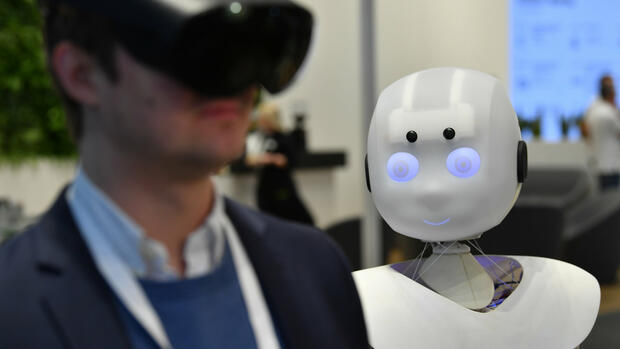Hanover How can delivery bottlenecks be foreseen? Which batch from a supplier was faulty? And how much CO2 is produced during the manufacture of a product? These are central questions for the German economy with key sectors such as the automotive and chemical, electrical and mechanical engineering industries, but only a few companies can answer them in detail: They lack the necessary data.
A well-known consortium from the economy wants to remedy this with the support of the state. Under the name Manufacturing-X, corporations such as Bosch, Telekom, SAP and Siemens as well as medium-sized companies such as DMG Mori and Trumpf are developing a concept for the digitization of supply chains in industry. The work officially begins with this week’s Hanover Fair, and a steering committee is now responsible for coordination.
Which scenarios should the new infrastructure cover? How much funding is the federal government providing? And when are the first commercial applications likely to be available? The Handelsblatt gives an overview of the central project of German industry.
What exactly is Manufacturing-X?
The initiators refer to Manufacturing-X as a data room. What is meant is an open environment for data exchange based on common rules and standards. This means: All companies – whether corporations, medium-sized companies or start-ups – can use the system and build their own applications on it.
There is no central infrastructure as with the big cloud providers Amazon Web Services, Microsoft or Google: The consortium wants to develop an architecture that should be openly available according to the open source principle. All cloud service providers can therefore make them available via their own systems, provided they comply with the rules.
Read more about the Hanover Fair:
Why is this necessary?
The intelligent use of data has been a major topic at the Hannover Messe and in the industry for years. The potential is great: machine builders and industrial groups can network supply chains for just-in-time production, maintain systems with foresight and offer new data-based services such as the minute-by-minute rental of machines – “as a service”, as is common in the IT industry is.
“However, data is only exchanged between companies on a selective basis and sharing data along the supply chain is still difficult in practice,” says Achim Berg, President of the IT association Bitkom. There is a lack of standards, of a uniform infrastructure – and often also of the willingness to exchange ideas with other providers.
Politicians see this as an opportunity to increase the competitiveness of industry. “For digital sovereignty, it is necessary to develop data-based solutions and business models,” says Bernhard Kluttig, who heads the industrial policy department at the Federal Ministry of Economics and Technology (BMWK). According to an earlier paper by the BMWK, the federal government wants to fund the project with 150 million euros, and the Bundestag will vote on it on Wednesday.
What examples are there?
How Manufacturing-X will one day work can be examined in another project: Catena-X serves as the basis for data exchange in the automotive industry and at the same time as a blueprint for networking other sectors. At the Hannover Messe, the initiative, founded in 2021, will show the first commercially ready applications that use the technology. In principle, they are also suitable for mechanical engineering.
Providers such as SAP and Siemens have developed programs with which car manufacturers can calculate the CO2 emissions of individual vehicles – depending on where the raw materials come from, how much energy is required for production or what emissions are caused by transport. The companies exchange production data via Catena-X, and the project also offers a uniform method for calculating the climate impact.
A large part of the emissions do not arise in the company’s own factory, but at suppliers, emphasizes Siemens board member Cedric Neike. Manufacturing-X can help capture these emissions. However, the climate impact can only be calculated down to the last link in the supply chain if all suppliers participate, right down to the mine operator who supplies lithium for the battery or iron ore for the body. But an approximation is now possible.
The companies are still working on applications for Manufacturing-X. A digital passport is conceivable, for example, which notes the production batch for each individual component – which should make it much easier to precisely recall products. The new infrastructure could also make it much easier to collect machine data – and thus to train algorithms with artificial intelligence.
>> Read here: Data plugs for the automotive industry – Catena-X is about to be launched
What is the schedule?
Work on Manufacturing-X is still in its infancy – the data room is little more than a concept so far. The companies involved must set up the organization and develop the technology under the umbrella of the Industry 4.0 platform. That alone can take several years.
After all, the initiators of Manufacturing-X can use Catena-X as a basis – the goal is “to transfer everything that can be recycled to the entire manufacturing industry,” says Georg Kube, who is responsible for marketing products in industry at SAP . This included, for example, parts of the program code and the set of rules, possibly even the club structure.
Last but not least, it is important to convince machine builders and industrial companies to use the platform. What the powerful car manufacturers can enforce through their tenders may require some convincing from the machine builders. If there is no specific use case “that brings money to the participating parties, it will be difficult,” said Tanja Rückert, head of digital at Bosch.
It is therefore clear in industry circles: It will probably be several years before Manufacturing-X is used for CO2 accounting or the tracking of components.
More: Tablet replaces the service technician – How AI is revolutionizing the industry
